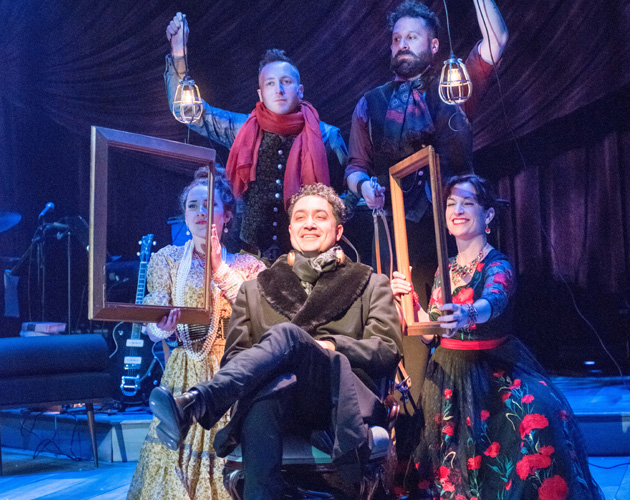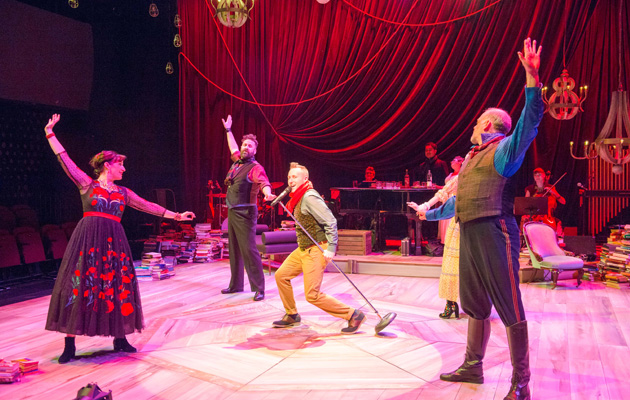ColorSource shines in award-winning musical
Date Posted: 10/13/2016

Written by Marshall Bissett
In the competitive Vancouver theater scene, winning a Jessie Award for Excellence is a big deal. When Arts Club Theatre Company's production of Onegin walked away with 10 Jessies, history was made. Adding to the list of firsts, designer John Webber, who won for Best Lighting Design, used an all-LED rig of ETC
ColorSource® fixtures.
Onegin, an original musical based on a Tchaikovsky opera and a poem by Pushkin, played on the thrust stage of the versatile BMO Theatre Centre in Vancouver. Director of Production Stephan Baeuml’s plans for this all-LED venue were formed at LDI 2014: “I met David
Neal of Christie Lites on the ETC booth and we looked at ETC’s first-generation
[Source Four LED Series 2] Lustr fixtures. Luckily, by the time we opened in 2015, the ColorSource was available. It was a leap of faith and one that has really paid off for us.” With three successful productions in the books, there seems to be no sign of my latest ETC
acronym: TSA (Tungsten Separation Anxiety). The all-LED room fits well with the City of Vancouver’s mandate to be one of the “greenest” cities on the planet.

Webber, a 20-year veteran of the Canadian theater scene, worked with set designer Drew Facey to meet the complex demands of the ambitious musical. The title is pronounced “Oh-nye-ghin” but which he jokingly refers to as “One Gin,” in honor of the drinks served during technical week. He found no need to supplement the basic
rig of 120 ColorSource engines that included 12
CYC attachments, 24
Fresnels, four zooms and a mixture of lens tubes.
Beyond the normal demands of lighting a large cast, multiple set changes and a live band, the production featured seven huge chandeliers and 40 industrial-style cage lamps. He describes a special use for the 12 fixtures set up as a branch gobo wash: “We were able to transform a fall forest scene with each lamp set as
its own rich, fall color into a twilight evening, and a cold, stark winter with two minutes of programming. Replacing all of the color settings we used in these 12 fixtures would have required about 60 conventional fixtures and taken a lot more time.” He was especially pleased with the precise color rendition
between units: “The trick with LED rigs is to create your own color palettes without trying to match the gel numbers you grew up with. Just use the swatch book as a guide in planning your color approach, otherwise you will get lost in all the possibilities for each fixture.”

In the musical’s climactic scene when the lead character kills his friend in a duel, a cue snaps every fixture to a deep red and slowly restores the original look, an effect that is not possible in a traditional rig. Webber’s only pang of fixture envy comes from his liking to “live on the edges of the color wheel” with the
highly saturated blues and greens. “I could maybe have used a couple of ETC Lustrs for that, but overall I was delighted with the system,” he says.
From a scheduling standpoint, Baeuml notes that an LED rig speeds up focus, because there are fewer fixtures, but adds to programming time: “It’s like the early days of moving lights. The creative team has so many possibilities that have to fit into the production schedule.”
Theaters that are hovering on the edge of the LED cliff can take encouragement from Baeuml, who believes that within five years ETC will have an LED retrofit for every traditional fixture in its lineup: “I did not want to put old technology into a new facility that has a future life of maybe 50 years. If you can’t buy
incandescent bulbs at the local Home Depot, I didn’t want them in my theater.”
Photos by David Cooper